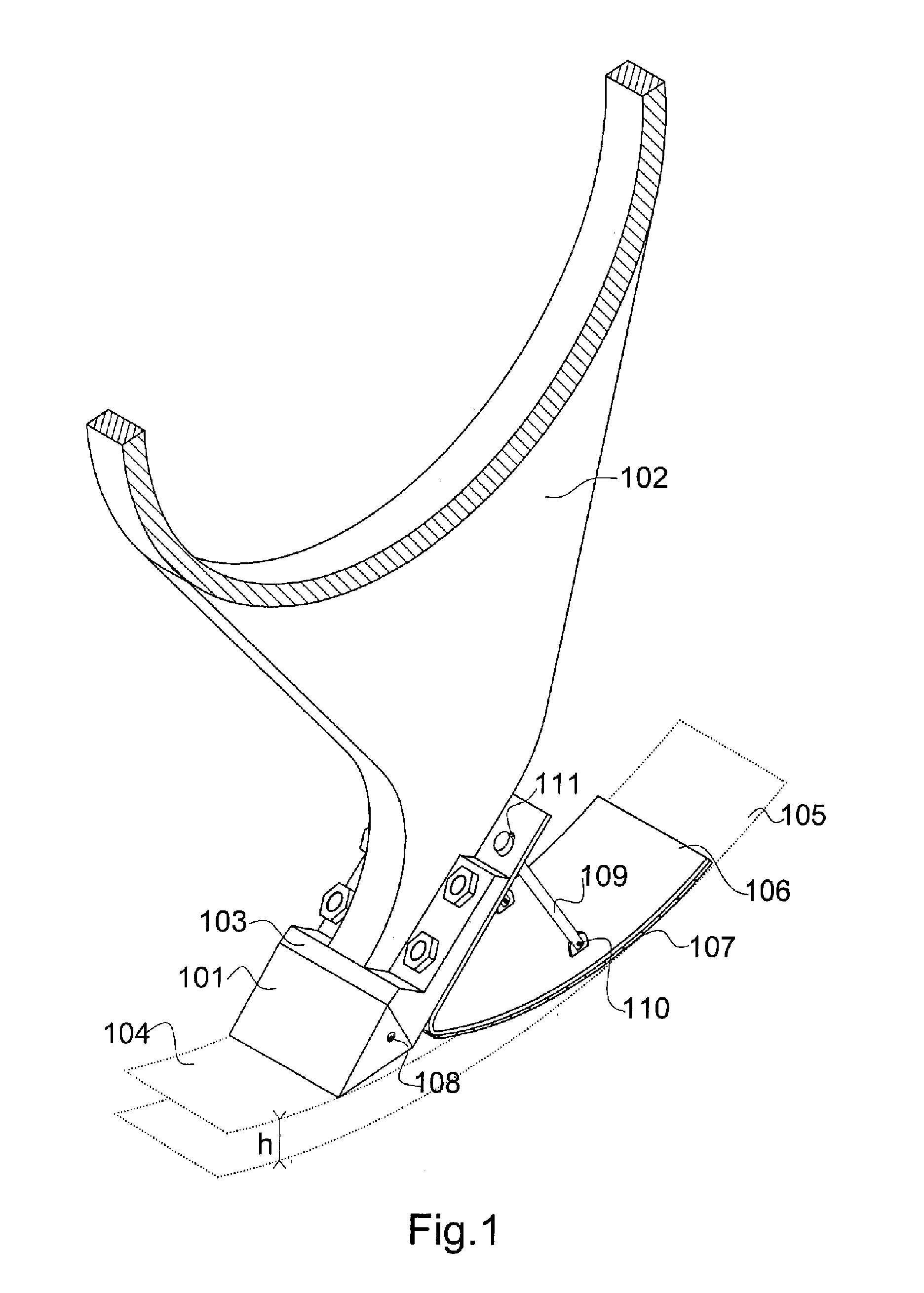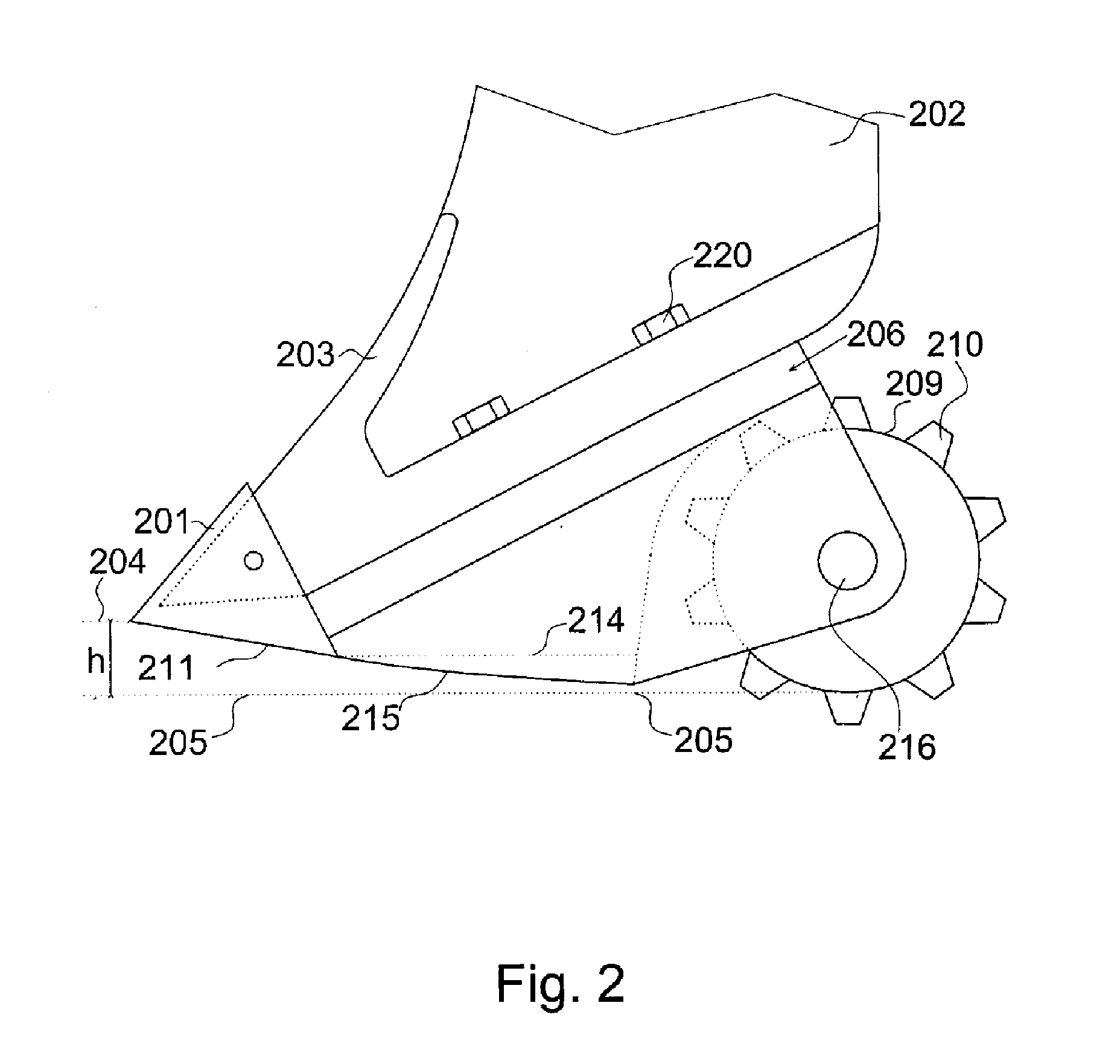Method for compacting soil, applications of this method and devices for its implementation
a soil compacting and soil technology, applied in soil preservation, railway tracks, roads, etc., can solve the problems of surface lamination detrimental to the long-term behavior/performance of the structure, the density obtained by compaction is not uniform throughout the thickness of the layer, and the stress induced within the material decreases
- Summary
- Abstract
- Description
- Claims
- Application Information
AI Technical Summary
Benefits of technology
Problems solved by technology
Method used
Image
Examples
first embodiment
[0066]In the embodiment of FIG. 2, there is a wedge 201, similar to the wedge 101, attached to a vertical post or to a rotor branch 202 by means of an intermediate part 203 which serves as a base for all the tools. The upper layer, again not shown in the Figure, is separated by the wedge 201 from the virtual surface 204 and is subjected to the same treatment as in the previous example. However, in this case, the wedge 201 is tilted downward so that its lower face 211 comes to press the surface 204 to achieve a first compaction that generates a real surface 214. Part 206, attached by bolts 220 to the plate of the base 203, is formed at the front by a short length base plate 215 and at the rear by a large cylinder which can be smooth or toothed, or be provided with sheep's foot rollers 210. This cylinder is tangent to the extension of the profile of the base plate. The cylinder rotates freely about an axis 216 retained by the sides of the part 206. In contact with the soil, the cylind...
third embodiment
[0067]In a third embodiment, shown in FIGS. 3 and 4, the stripping member is reduced to a simple wear plate 301 particularly resistant, for example in tungsten carbide, attached to an intermediate part 303 by welding or possibly by removable means. This intermediate part acts, as above, as a common support to the blade 301 and to the members described below. The upper layer of the soil, not shown, is treated as in the two previous embodiments. The compaction of the virtual surface 304, allowing to bring this surface 304 back at the desired level of the surface 305 by a compacting of a height h, is obtained in this embodiment by a set of small rollers 309 of small diameter. These rollers are arranged substantially next to each other, parallel to the surface of the soil and perpendicular to the direction of motion of the device. They are attached to another intermediate part 313 which has in this embodiment, downwardly, substantially a U shape with two vertical wings on the sides and ...
fourth embodiment
[0068]FIG. 5 shows known members which can be used in a
[0069]These members include an intermediate part 503 which can be mounted on any support, such as for example a branch of a star 522, through a transverse hole 502 and a bolt not shown. It also includes a longitudinal hole, not visible in the Figure, to receive soil milling tools, such as a pick 511 or a tooth 501 / 531, which are maintained by a key 504. It is to be noted that the pick 511 and the tooth 531 are particularly reinforced as compared to the standard tooth 501.
[0070]A fourth embodiment, shown according to a first example in FIG. 6, comprises an intermediate part as described above, completed by a flat part 513 attached, for example by welding, on the lower end of the part 503 to obtain an intermediate part within the meaning of the invention.
[0071]This intermediate part is fixed by its hole 502 to a vertical post 522 of a frame, or to the end of a branch of a star. It is provided for example with a pick 511 or a tooth...
PUM
 Login to View More
Login to View More Abstract
Description
Claims
Application Information
 Login to View More
Login to View More - R&D
- Intellectual Property
- Life Sciences
- Materials
- Tech Scout
- Unparalleled Data Quality
- Higher Quality Content
- 60% Fewer Hallucinations
Browse by: Latest US Patents, China's latest patents, Technical Efficacy Thesaurus, Application Domain, Technology Topic, Popular Technical Reports.
© 2025 PatSnap. All rights reserved.Legal|Privacy policy|Modern Slavery Act Transparency Statement|Sitemap|About US| Contact US: help@patsnap.com



